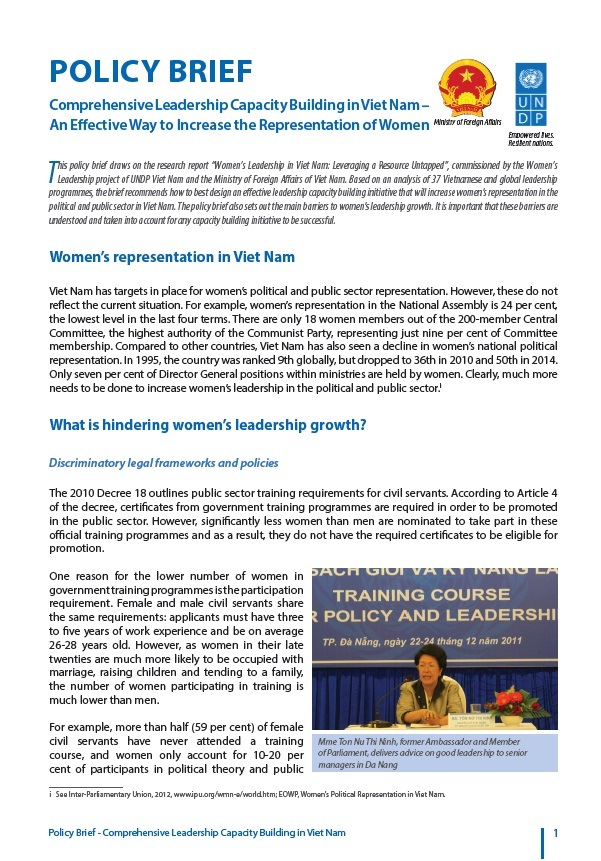Policy Brief: Comprehensive Leadership Capacity Building in Viet Nam – An Effective Way to Increase the Representation of Women
This policy brief draws on the research report “Women’s Leadership in Viet Nam: Leveraging a Resource Untapped”, commissioned by the Women’s Leadership project of UNDP Viet Nam and the Ministry of Foreign Affairs of Viet Nam. Based on an analysis of 37 Vietnamese and global leadership programmes, the brief recommends how to best design an effective leadership capacity building initiative that will increase women’s representation in the political and public sector in Viet Nam. The policy brief also sets out the main barriers to women’s leadership growth. It is important that these barriers are understood and taken into account for any capacity building initiative to be successful.
Women’s representation in Viet Nam
Viet Nam has targets in place for women’s political and public sector representation. However, these do not reflect the current situation. For example, women’s representation in the National Assembly is 24 per cent, the lowest level in the last four terms. There are only 18 women members out of the 200-member Central Committee, the highest authority of the Communist Party, representing just nine per cent of Committee membership. Compared to other countries, Viet Nam has also seen a decline in women’s national political representation. In 1995, the country was ranked 9th globally, but dropped to 36th in 2010 and 50th in 2014. Only seven per cent of Director General positions within ministries are held by women. Clearly, much more needs to be done to increase women’s leadership in the political and public sector.[1]
Key elements of a successful women’s leadership initiative
In order to be successful, a comprehensive capacity building initiative to promote women’s political and public sector leadership needs to take all these barriers into account when designing its approach. Being aware of existing barriers will, for instance, help to determine how to select participants, how to effectively address stereotypes and how to address women’s training needs, such as helping them to build career support networks. In addition, any initiative, whether new or existing, needs to address the following recommendations if it is to have substantial impact.
[1] See Inter-Parliamentary Union, 2012, www.ipu.org/wmn-e/world.htm; EOWP, Women’s Political Representation in Viet Nam.
Full text of Policy brief “Comprehensive Leadership Capacity Building in Viet Nam – An Effective Way to Increase the Representation of Women”: policybriefonleadershipcapacityb.pdf

- Hôm nay 515
- Tổng lượt truy cập 6,864,695


Bình luận từ Facebook
Phản hồi